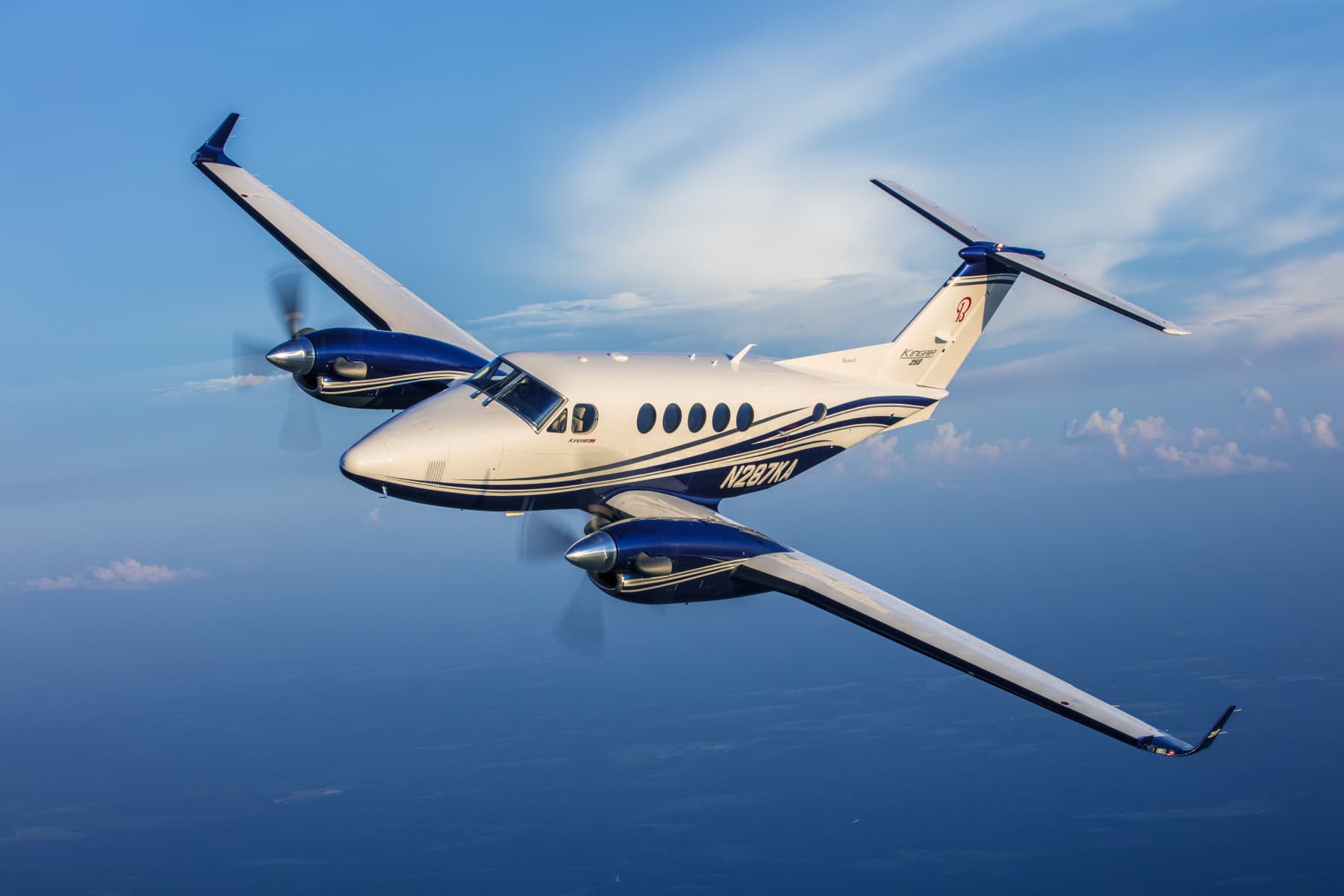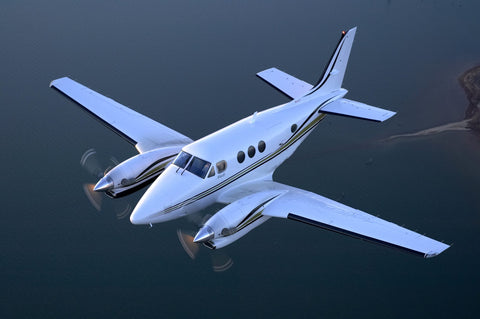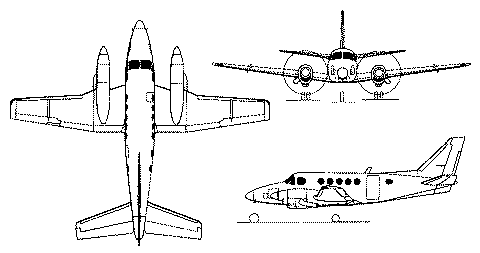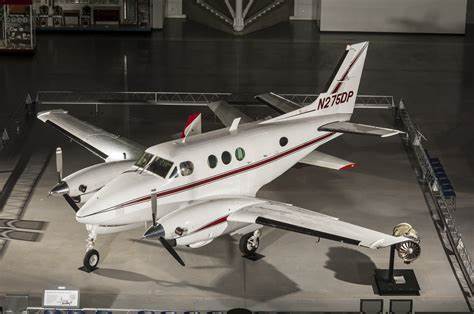
#3 in our 100 in 100, the Beechcraft King Air 🛫
Conceptualization:
The Beechcraft King Air was born out of a clear market need and a visionary approach to aircraft design. In the early 1960s, the aviation industry was experiencing rapid growth, with increasing demands for a new breed of aircraft that could bridge the gap between the small, light aircraft and the larger, more expensive airliners of the time. Pilots and operators were looking for an aircraft that could offer greater range, higher speed, and more capacity than the light aircraft, yet remain more cost-effective, easier to operate, and less complex than the jet airliners.
Beechcraft, recognizing these evolving market trends and pilot demands, set out to design an aircraft that could meet these specific needs. The result was the introduction of the King Air in 1964. The King Air was conceptualized as a twin-engine turboprop that could provide the perfect balance between performance and operational costs. It was designed to operate from shorter runways, a crucial feature that allowed access to more airports and thus greater flexibility for pilots and businesses alike. This capability opened up new opportunities for companies to expand their reach without the need for large-scale airport infrastructure.
The turboprop engines of the King Air were crucial in terms of efficiency, operating costs, and performance, making the King Air an attractive option for a wide range of operations, from corporate travel to cargo and ambulance services. The choice of turboprop power also positioned the King Air as a more economical alternative to jet aircraft, while still providing a high level of performance and reliability.
The initial concept of the King Air also focused on comfort and versatility. Beechcraft designed the cabin to be spacious and comfortable, with enough room for passengers to work or relax during flights. This focus on passenger experience, combined with the aircraft's operational versatility, made the King Air a popular choice not only for business aviation but also for governmental and military applications around the world.

Original Design:
The original design of the Beechcraft King Air incorporated several standout features that directly catered to its intended uses, which ranged from corporate travel and cargo transport to military and training applications. From its inception, the King Air was designed to be a versatile, high-performance turboprop aircraft, and its design elements reflect this focus.
Twin Turboprop Engines: As mentioned above, one of the most significant design features of the King Air is its twin turboprop engines. These engines provided a balance of speed, range, and efficiency that was unmatched at the time of its introduction. The use of turboprop engines instead of piston engines offered improved reliability and performance, particularly at higher altitudes. This made the King Air suitable for a wide range of operations, including those in challenging environments and remote locations with shorter runways where jet aircraft could not operate effectively.
Pressurized Cabin: The King Air was among the first in its class to offer a pressurized cabin, a feature that significantly enhanced passenger comfort and safety during flight. This allowed the aircraft to fly above adverse weather conditions at higher altitudes, resulting in smoother, faster trips. The pressurized cabin also opened up the King Air to a broader market, including corporate and VIP transport, where comfort is a priority.
Versatile Cabin Configuration: The cabin of the King Air could be easily reconfigured to accommodate different missions, from carrying passengers in a comfortable seating arrangement to transporting cargo. This adaptability made the King Air attractive to various sectors, including air ambulance services, where the ability to quickly reconfigure the interior for medical equipment and stretchers is crucial.
Advanced Avionics and Systems: For its time, the King Air featured advanced avionics and systems that enhanced its navigational capabilities and safety. The aircraft was equipped with state-of-the-art instruments and navigation aids that made it easier to fly and maintain, especially in poor weather conditions. This focus on advanced technology made the King Air a preferred aircraft for training military pilots and other specialized applications where reliability and performance are critical.
Robust Landing Gear: The King Air's robust landing gear was designed to handle the demands of frequent takeoffs and landings, including operations on unimproved runways. This feature contributed to the aircraft's versatility, allowing it to access more remote and rugged locations than many of its competitors.
The original design of the Beechcraft King Air, with its emphasis on reliability, versatility, and performance, directly catered to its intended uses across various sectors. Thus, making the King Air a highly adaptable and capable aircraft for a wide range of missions, from personal and corporate use to training and specialized military applications.

Design Team:
The Beechcraft King Air was developed under the stewardship of Beech Aircraft Corporation, now part of Textron Aviation. While specific names of the designers or the design team directly responsible for the King Air are not as widely publicized as in some other aircraft projects, the development of the King Air was overseen by a group of skilled engineers and designers at Beechcraft who had a profound background in aviation design and innovation.
At the helm of Beechcraft's innovative endeavors during the King Air's conceptual and development phases was Ralph Harmon, an influential figure in aviation engineering. Ralph Harmon's contributions to aviation were not limited to the King Air; his career was marked by significant achievements and leadership in the design and development of several notable aircraft.
Before the King Air, Ralph Harmon played a pivotal role in the development of the Beechcraft Bonanza, one of the most iconic and enduring aircraft in general aviation history. The Bonanza, with its distinctive V-tail (a design feature that Harmon himself was a strong proponent of), set new standards in aircraft design and performance when it was introduced in 1947.
After the successful launch of the Bonanza, Beechcraft continued to innovate under Harmon's leadership, leading to the development of the Twin Bonanza and then the Queen Air. The Queen Air, which served as a precursor to the King Air, embodied many of the design philosophies that would be refined and advanced in the King Air series. The transition from the Queen Air to the King Air represented Beechcraft's commitment to leveraging turboprop technology to achieve higher performance and greater efficiency.
The expertise and innovative spirit of Beechcraft's design team, under the guidance of leaders like Ralph Harmon, were instrumental in the development of the King Air. Their extensive background in aviation design, characterized by a blend of practicality and forward-thinking, laid the foundation for the King Air's success. The design team's ability to anticipate and meet market needs, along with their experience gained from previous projects, were crucial in creating an aircraft that would stand the test of time.
Following the King Air, Beechcraft's tradition of excellence in aviation design continued with further innovations and developments in the King Air family and beyond, solidifying the company's reputation for quality, performance, and reliability in the aviation industry.
Production Run:
The Beechcraft King Air boasts a production history that is both extensive and ongoing, making it one of the most successful aircraft in its class. The King Air was first introduced in 1964, marking the beginning of a production run that has continued for nearly six decades, a testament to its enduring popularity and adaptability to evolving market needs.
Initial Production and Evolution: The first model to enter production was the King Air 90, which set the stage for a series of developments and enhancements over the years. Following the success of the initial model, Beechcraft expanded the King Air line with various models, including the King Air 100 series, introduced in 1969, and the larger King Air 200 series, introduced in 1974. The King Air 300/350 series, offering further improvements in performance and capacity, entered the market in 1984.
Production Volume and Milestones: More than 7,000 King Air aircraft have been produced across all variants. This figure underscores the aircraft's widespread acceptance and the high demand across different market segments, including corporate, military, and special mission applications. The production volume of the King Air has seen fluctuations over the years, influenced by economic conditions, competition, and advancements in aviation technology. However, the King Air family has consistently maintained a strong presence in the market, thanks in part to ongoing updates and enhancements that have kept the aircraft competitive.
Significant Updates and Continuation: The introduction of the King Air 350i, with its state-of-the-art avionics' suite and enhanced passenger comfort features, represented a significant leap forward in the aircraft's evolution.
Beechcraft, now part of Textron Aviation, has continued to invest in the King Air family, introducing upgraded models like the King Air 360 and 360ER, which feature further enhancements in comfort, performance, and technology. These ongoing updates ensure that the King Air remains relevant and desirable in the competitive aviation market.
Current Status: Production of the Beechcraft King Air series continues, with the aircraft remaining a popular choice for a variety of applications worldwide. The continued production and introduction of new models reflect the aircraft's ability to evolve with changing technologies and market demands, ensuring its place in the skies for years to come.
The Beechcraft King Air's enduring success is a testament to the original design's versatility and the ongoing commitment to enhancing its capabilities to meet the needs of modern aviation.

Evolution:
Throughout its illustrious production run, the Beechcraft King Air has seen a series of significant upgrades, modifications, and the introduction of new variants, each designed to improve upon the original design in response to advancements in technology, shifts in market demands, and the evolving needs of its diverse user base. This evolution has helped maintain the King Air's status as a premier aircraft in its class, catering to a wide range of missions from corporate travel to air ambulance services, and even military applications.
King Air 90 Series: The King Air lineage began with the Model 90 series. Over time, this series saw several upgrades, including the A90, B90, C90, and E90, each offering improvements in engine performance, avionics, and comfort. The C90GTx, one of the latest iterations, features enhanced performance with upgraded engines and increased gross weight capacity, demonstrating the model's continuous improvement over time.
King Air 100 Series: Introduced as a larger alternative to the Model 90 series, the 100 series provided more space and power. Variants like the A100 and B100 offered different engine configurations and improved performance metrics, catering to users requiring more cabin space and payload capacity.
King Air 200 Series: A significant leap in the evolution of the King Air family, the 200 series brought a new level of performance and comfort. The introduction of the Super King Air 200 and later the B200 featured more powerful engines, greater range, and a larger cabin. The 200 series also saw the introduction of winglets in some variants, improving aerodynamics and efficiency.
King Air 300/350 Series: Representing the pinnacle of the King Air line, the 300 and 350 series offered further enhancements in performance, capacity, and luxury. The 350i, for example, introduced state-of-the-art avionics with the Rockwell Collins Pro Line Fusion avionics suite, improved interior design for enhanced passenger comfort, and noise-reducing features, making it one of the most sophisticated turboprops in the market.
Technological and Performance Enhancements:
Avionics: Across its evolution, the King Air series has seen substantial avionics upgrades, moving from relatively basic instrumentation to incorporating advanced glass cockpit technologies. These upgrades have enhanced navigational capabilities, safety, and ease of operation.
Engine Performance: Upgrades to the Pratt & Whitney Canada turboprop engines in various King Air models have resulted in increased efficiency, reliability, and performance, including higher speeds and longer range.
Comfort and Versatility: Improvements in cabin comfort, such as noise reduction, enhanced climate control, and luxurious cabin fittings, have made the King Air a preferred choice for executive transport. The versatile cabin configurations, capable of quick conversion between passenger, cargo, or mixed-use layouts, have further solidified its appeal across a broad spectrum of operations.
Safety Features: The incorporation of enhanced safety features, including advanced weather radar, collision avoidance systems, and terrain awareness and warning systems, has kept the King Air at the forefront of aviation safety standards.
The evolution of the Beechcraft King Air reflects Beechcraft's (now part of Textron Aviation) commitment to innovation, quality, and responsiveness to customer needs. By continuously incorporating technological advancements, performance improvements, and luxury enhancements, the King Air has not only improved upon its original design but has also maintained its relevance and desirability in a highly competitive market.
Specifications:
Beechcraft King Air 350i Specifications
- Crew: 1-2
- Passenger Capacity: Up to 11, depending on configuration
- Length: 46 ft 8 in (14.22 m)
- Wingspan: 57 ft 11 in (17.65 m)
- Height: 14 ft 4 in (4.37 m)
- Wing Area: 303 sq ft (28.2 sq m)
- Empty Weight: 9,290 lbs. (4,214 kg)
- Maximum Takeoff Weight (MTOW): 15,000 lbs. (6,804 kg)
- Powerplant: 2 × Pratt & Whitney Canada PT6A-60A turboprop engines, 1,050 shp. (783 kW) each
- Maximum Cruise Speed: 312 knots (359 mph, 578 km/h)
- Range: 1,806 nm (2,078 mi, 3,345 km) with max fuel and 45 min reserve
- Service Ceiling: 35,000 ft (10,668 m)
- Rate of Climb: 2,730 ft/min (13.9 m/s)
- Fuel Capacity: 539 gal (2,040 L)
Comparative Analysis:
When comparing the King Air 350i to other aircraft in its class, such as the Pilatus PC-12 and the Cessna Caravan series, several key aspects stand out:
Range and Speed: The King Air 350i typically offers a higher maximum cruise speed and longer range than the Cessna Caravan, making it suitable for longer missions where speed is a priority. Compared to the Pilatus PC-12, the King Air 350i is competitive, with both aircraft offering similar ranges and speeds, although specific performance can vary based on load and conditions.
Capacity: With seating for up to 11 passengers, the King Air 350i can accommodate more passengers than the standard configurations of both the Pilatus PC-12 and the Cessna Caravan, making it a preferred choice for larger groups or corporate travel.
Powerplant and Performance: The twin-engine configuration of the King Air 350i provides redundancy that is appreciated in overwater or remote area flights, offering a level of safety and reliability that single-engine aircraft like the Pilatus PC-12 and Cessna Caravan cannot match.
Versatility and Operational Flexibility: The King Air 350i's ability to operate from shorter runways, combined with its pressurized cabin and versatile cabin configurations, makes it exceptionally well-suited for a wide range of missions, from corporate and leisure travel to medevac and cargo transport.
Performance:
Performance Envelope of the Beechcraft King Air 350i
V-Speeds:
- V1 (Decision Speed): The speed by which a decision to continue takeoff after an engine failure must be made.
- VR (Rotation Speed): The speed at which the nose is raised, and takeoff is initiated.
- V2 (Takeoff Safety Speed): The minimum speed to be maintained after takeoff if an engine fails.
- Vref (Landing Reference Speed): Speed at which the aircraft approaches for landing, typically 1.3 times the stall speed in the landing configuration.
- VMO (Maximum Operating Speed): The maximum speed at which the aircraft can be safely flown.
- VS1 (Stall Speed, Clean): The speed at which the aircraft will stall with no flaps or gear down.
- VSO (Stall Speed, in Landing Configuration): The speed at which the aircraft will stall with full flaps and gear down.
Exact V-speed values are specific to each King Air model and its current weight, altitude, and configuration.
G-Load Limitations:
- Normal Operating Range: Typically, for civil turboprop aircraft like the King Air, the G-load limitations are around +3.8 Gs to -1.52 Gs for the normal category.
- Utility Category: Some aircraft may have utility categories allowing for slightly higher G-load operations, but specifics would be detailed in the aircraft's operating handbook.
Approved Maneuvers:
- The King Air series, designed primarily for transport and not aerobatic flight, is approved for standard operational maneuvers necessary for its role. These include takeoffs, landings, standard turns, climbs, and descents.
- Not approved for aerobatic maneuvers such as loops, rolls, or spins.
Suitability for Training and Personal Aviation
- Training: The King Air's performance characteristics make it an excellent platform for advanced flight training, including multi-engine training, instrument flight rules (IFR) navigation, and turboprop handling skills. Its sophisticated avionics suite and performance envelope offer trainees exposure to systems and flight conditions they would encounter in commercial and corporate aviation.
- Personal Aviation: For personal use, the King Air's versatility, reliability, and performance envelope make it highly suited for a range of missions, from short hops to longer cross-country flights. Its ability to operate from shorter runways, combined with its high-speed cruise capability and spacious cabin, ensures both convenience and comfort for the pilot and passengers.
Safety Record:
- Engine and Systems Reliability: While the Pratt & Whitney Canada turboprop engines used in King Airs are renowned for their reliability, engine failures or malfunctions have been cited in several incidents. Regular maintenance and adherence to manufacturer's guidelines are crucial for minimizing risks.
- Operational Challenges: Given its versatility, the King Air is often used in challenging conditions, such as unimproved runways or adverse weather. Pilot experience and decision-making are critical in mitigating risks associated with these operations.
- Stall and Loss of Control: Like all aircraft, King Airs are susceptible to stalls and loss of control if not operated within their performance envelope. Training and proficiency in recognizing and recovering from stalls are essential safety measures.
Notable Incidents:
- The King Air series has been involved in various incidents over the years, including runway overruns, collisions with obstacles during takeoff or landing, and mid-air engine failures. Investigations often point to a combination of pilot error, adverse weather conditions, and occasionally mechanical issues.
- Notably, many incidents involving King Airs that resulted in adverse outcomes were attributed to pilot error or external factors rather than inherent design flaws.
Safety Record Comparison:
- When compared to other aircraft in its category, such as the Pilatus PC-12 or the Cessna Caravan series, the King Air maintains a competitive safety record. Each of these aircraft types serves similar roles and operates in comparable environments, and their safety records reflect the high standards of design, engineering, and operational protocols in modern aviation.
- The King Air's continued updates and improvements, especially in avionics and engine performance, have helped enhance its safety profile over time. The introduction of features like advanced terrain awareness and warning systems (TAWS), traffic collision avoidance systems (TCAS), and modernized flight decks has contributed to reducing pilot workload and increasing situational awareness.
Acquisition Cost:
The acquisition cost of the Beechcraft King Air has evolved significantly since its introduction in the 1960s, reflecting both the advancements in technology and inflation over time. Initially, the pricing for the King Air series would have been significantly lower than today's values, considering technological advancements and inflation.
June 8, 1964 – Beech sets the initial price at $320,000 for a fully equipped King Air.
In recent years, the price of a new King Air 350i, a popular model in the King Air series, is around $8 million. For pre-owned models, the cost varies significantly based on the year of manufacture, condition, and total flight hours. For instance, King Air 350 models from 2009 to 2011 can range from $4 million to $4.5 million, and models from the late 1990s to early 2000s are typically priced between $2 million to $2.5 million.
Comparing these figures to the pricing details from 2019, a C90GTx model was priced at approximately $4.2 million, adjusted to around $4.76 million in 2022 values. This shows a consistent increase in value, reflecting both the aircraft's enduring appeal and the general inflationary trends affecting acquisition costs in the aviation industry.
For pilots and aircraft maintainers considering the acquisition of a King Air, whether new or pre-owned, it's crucial to weigh the initial purchase price against the operational costs, the aircraft's capabilities, and the specific mission requirements. The King Air's reputation for durability and low operating costs relative to its performance makes it a compelling choice in its class.
Conclusion:
The Beechcraft King Air stands out as a true aviation marvel. From its inception in the 1960s to its enduring presence in the skies today, the King Air embodies the perfect blend of reliability, versatility, and performance. This aircraft has not only set the standard for what a twin-turboprop can achieve but also continues to evolve, meeting the demands of modern aviation with grace and efficiency.
Through its various iterations, the King Air has served countless roles - from corporate travel and air ambulance services to military applications, proving its adaptability and resilience. Its design, characterized by robust engines, advanced avionics, and a comfortable cabin, caters to a broad audience, including pilots, passengers, and aviation enthusiasts alike.
The Beechcraft King Air's legacy is a testament to the vision of its creators and the dedication of those who have piloted, maintained, and loved these aircraft over the decades. As we reflect on its journey, it's clear that the King Air is not just an airplane; it's an icon of the skies that continues to inspire and lead the way in aviation excellence.
Bibliography:
For those looking to delve deeper into the Beechcraft King Air's rich history, design, performance, and operational nuances, several authoritative and reliable sources provide a wealth of information:
- Textron Aviation: As the current manufacturer of the Beechcraft King Air series, Textron Aviation's official website is an excellent starting point for detailed product specifications, updates, and service information for the entire King Air family.
- Textron Aviation - King Air
- FAA Registry: For regulatory and certification information, including airworthiness directives that affect the King Air series, the FAA Registry offers comprehensive data.
- National Transportation Safety Board (NTSB): The NTSB provides access to aviation accident reports involving the King Air series, offering insights into safety records and incident analyses.
- Aircraft Owners and Pilots Association (AOPA): AOPA offers a variety of resources, including operational and safety articles, training materials, and a vibrant community forum where pilots and owners can share experiences and advice.
- Beechcraft Heritage Museum: For those interested in the history and legacy of Beechcraft, including the development of the King Air series, the Beechcraft Heritage Museum provides historical archives and exhibits.
- Pilot forums and online communities such as Reddit’s r/flying and PPRuNe (The Professional Pilots Rumor Network) offer real-world experiences, tips, and discussions from King Air pilots and enthusiasts.
- Reddit - r/flying
- PPRuNe
